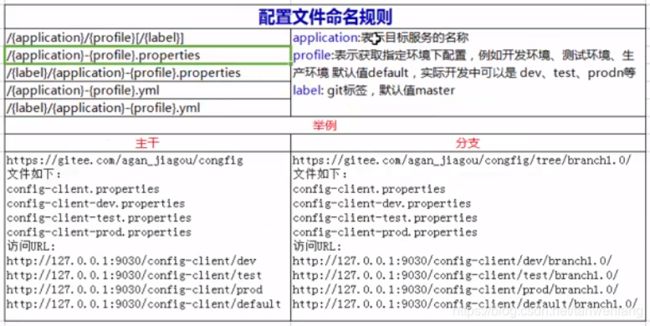微服务架构学习-进阶篇--08,分布式配置中心(上)
第一节,为什么需要配置中心?它解决了什么问题?
第二节,编写配置中心的服务端
(1)在e-book模块下新建子模块config,在config模块下新建maven项目,命名为config-server。
(2)修改配置文件,加入如下依赖:
org.springframework.boot
spring-boot-starter-web
org.springframework.cloud
spring-cloud-config-server
(3)修改配置文件。
spring.application.name=config-server
server.port=8121
eureka.client.serviceUrl.defaultZone=http://user:123456@eureka1:8761/eureka/,http://user:123456@eureka2:8762/eureka/
spring.cloud.config.label=master
spring.cloud.config.server.git.uri=https://github.com/tanwenfang/GitRepository.git
spring.cloud.config.server.git.search-paths=config
(4)添加启动类。
package com.twf.config.server;
import org.springframework.boot.SpringApplication;
import org.springframework.boot.autoconfigure.SpringBootApplication;
import org.springframework.cloud.config.server.EnableConfigServer;
import org.springframework.cloud.netflix.eureka.EnableEurekaClient;
@SpringBootApplication
@EnableConfigServer
@EnableEurekaClient
public class ConfigServerApplication {
public static void main(String[] args) {
SpringApplication.run(ConfigServerApplication.class, args);
}
}
(5)在GitHub上新建4个配置文件,目录如下:https://github.com/tanwenfang/GitRepository/tree/master/config,
文件如下:

里面随便写点啥。
(6)然后浏览器访问http://localhost:8121/config-client/dev,界面如下:

(7)配置文件命名规则。

我们上面用的是第二种。
第三节,编写配置中心的客户端
(1)在config模块下新建maven项目,命名为config-client。
(2)修改pom文件,添加依赖:
org.springframework.boot
spring-boot-starter-web
org.springframework.cloud
spring-cloud-starter-config
(3)添加配置文件,命名为bootstrap.properties(一定要命名为bootstrap,否则会报错,因为bootstrap会在application之前被加载),添加如下配置:
spring.application.name=config-client
server.port=8122
eureka.client.serviceUrl.defaultZone=http://user:123456@eureka1:8761/eureka/,http://user:123456@eureka2:8762/eureka/
#默认false,这里设置true,表示开启读取配置中心的配置
spring.cloud.config.discovery.enabled=true
#对应eureka中的配置中心serviceId,默认是configserver
spring.cloud.config.discovery.serviceId=config-server
#指定环境
spring.cloud.config.profile=dev
#git标签
spring.cloud.config.label=master
(4)添加启动类。
package com.twf.config.client;
import org.springframework.boot.SpringApplication;
import org.springframework.boot.autoconfigure.SpringBootApplication;
import org.springframework.cloud.netflix.eureka.EnableEurekaClient;
@SpringBootApplication
@EnableEurekaClient
public class ConfigClientApplication {
public static void main(String[] args) {
SpringApplication.run(ConfigClientApplication.class, args);
}
}
(5)添加一个测试类,用于获取配置中心中的配置。
package com.twf.config.client.controller;
import org.springframework.beans.factory.annotation.Value;
import org.springframework.web.bind.annotation.RequestMapping;
import org.springframework.web.bind.annotation.RestController;
@RestController
public class TestController {
@Value("${book.config}")
private String msg;
@RequestMapping("/test")
public String test() {
return this.msg;
}
}
(6)启动config-server和该项目,浏览器访问http://localhost:8122/test,结果如下:

这个配置就是配置中心里面的配置文件config-client-dev.properties中的配置内容。
第四节,配置中心的原理讲解

我们在git上将config-client-dev.properties的内容改为“book.config=dev1.1“,然后启动config-server,再启动config-client。浏览器访问http://localhost:8122/test,浏览器显示“dev1.1”,后台打印如下:

可见重启之后,远程仓库的配置修改已经同步到本地仓库,我们查看本地仓库C:\Users\twf\AppData\Local\Temp\config-repo-538154066878725364\config,打开config-client-dev.properties,内容也是“book.config=dev1.1”
第五节,在git端修改配置后,如何让客户端生效
上面例子为了使配置文件生效,是重新启动了服务的。那么如何在不重启服务的情况下更新配置信息呢?
(1)在config模块下新建maven项目,命名为config-client-refresh,拷贝config-client的文件和代码到该新建项目。
(2)修改pom文件:
org.springframework.boot
spring-boot-starter-web
org.springframework.cloud
spring-cloud-starter-config
org.springframework.boot
spring-boot-starter-actuator
(3)修改配置文件。
spring.application.name=config-client
server.port=8123
eureka.client.serviceUrl.defaultZone=http://user:123456@eureka1:8761/eureka/,http://user:123456@eureka2:8762/eureka/
#默认false,这里设置true,表示开启读取配置中心的配置
spring.cloud.config.discovery.enabled=true
#对应eureka中的配置中心serviceId,默认是configserver
spring.cloud.config.discovery.serviceId=config-server
#指定环境
spring.cloud.config.profile=dev
#git标签
spring.cloud.config.label=master
#springboot 默认开启了权限拦截会导致 /refresh出现401,拒绝访问
management.security.enabled=false
(4)修改测试类。
package com.twf.config.client.refresh.controller;
import org.springframework.beans.factory.annotation.Value;
import org.springframework.cloud.context.config.annotation.RefreshScope;
import org.springframework.web.bind.annotation.RequestMapping;
import org.springframework.web.bind.annotation.RestController;
@RestController
@RefreshScope // 局部刷新
public class TestController {
@Value("${book.config}")
private String msg;
@RequestMapping("/test")
public String test() {
return this.msg;
}
}
(5)在e-book模块下新建maven项目,命名为commons。
(6)修改pom文件,添加依赖。
org.apache.httpcomponents
httpclient
4.5.4
commons-logging
commons-logging
1.2
(7)拷贝一个发请求的http工具类,如下:
package com.twf.commons;
import java.io.IOException;
import java.net.URI;
import java.util.ArrayList;
import java.util.List;
import java.util.Map;
import org.apache.http.NameValuePair;
import org.apache.http.client.entity.UrlEncodedFormEntity;
import org.apache.http.client.methods.CloseableHttpResponse;
import org.apache.http.client.methods.HttpGet;
import org.apache.http.client.methods.HttpPost;
import org.apache.http.client.utils.URIBuilder;
import org.apache.http.entity.ContentType;
import org.apache.http.entity.StringEntity;
import org.apache.http.impl.client.CloseableHttpClient;
import org.apache.http.impl.client.HttpClients;
import org.apache.http.message.BasicNameValuePair;
import org.apache.http.util.EntityUtils;
public class HttpClientUtil {
public static void main(String[] args) {
String url="http://127.0.0.1:8123/refresh"; // 重点在这里
String html=HttpClientUtil.doPost(url);
System.out.println(html);
}
public static String doGet(String url, Map param) {
// 创建Httpclient对象
CloseableHttpClient httpclient = HttpClients.createDefault();
String resultString = "";
CloseableHttpResponse response = null;
try {
// 创建uri
URIBuilder builder = new URIBuilder(url);
if (param != null) {
for (String key : param.keySet()) {
builder.addParameter(key, param.get(key));
}
}
URI uri = builder.build();
// 创建http GET请求
HttpGet httpGet = new HttpGet(uri);
// 执行请求
response = httpclient.execute(httpGet);
// 判断返回状态是否为200
if (response.getStatusLine().getStatusCode() == 200) {
resultString = EntityUtils.toString(response.getEntity(), "UTF-8");
}
} catch (Exception e) {
e.printStackTrace();
} finally {
try {
if (response != null) {
response.close();
}
httpclient.close();
} catch (IOException e) {
e.printStackTrace();
}
}
return resultString;
}
public static String doGet(String url) {
return doGet(url, null);
}
public static String doPost(String url, Map param) {
// 创建Httpclient对象
CloseableHttpClient httpClient = HttpClients.createDefault();
CloseableHttpResponse response = null;
String resultString = "";
try {
// 创建Http Post请求
HttpPost httpPost = new HttpPost(url);
// 创建参数列表
if (param != null) {
List paramList = new ArrayList<>();
for (String key : param.keySet()) {
paramList.add(new BasicNameValuePair(key, param.get(key)));
}
// 模拟表单
UrlEncodedFormEntity entity = new UrlEncodedFormEntity(paramList,"utf-8");
httpPost.setEntity(entity);
}
// 执行http请求
response = httpClient.execute(httpPost);
resultString = EntityUtils.toString(response.getEntity(), "utf-8");
} catch (Exception e) {
e.printStackTrace();
} finally {
try {
response.close();
} catch (IOException e) {
// TODO Auto-generated catch block
e.printStackTrace();
}
}
return resultString;
}
public static String doPost(String url) {
return doPost(url, null);
}
public static String doPostJson(String url, String json) {
// 创建Httpclient对象
CloseableHttpClient httpClient = HttpClients.createDefault();
CloseableHttpResponse response = null;
String resultString = "";
try {
// 创建Http Post请求
HttpPost httpPost = new HttpPost(url);
// 创建请求内容
StringEntity entity = new StringEntity(json, ContentType.APPLICATION_JSON);
httpPost.setEntity(entity);
// 执行http请求
response = httpClient.execute(httpPost);
resultString = EntityUtils.toString(response.getEntity(), "utf-8");
} catch (Exception e) {
e.printStackTrace();
} finally {
try {
response.close();
} catch (IOException e) {
// TODO Auto-generated catch block
e.printStackTrace();
}
}
return resultString;
}
}
(8)重启config-server,config-client-refresh。
(9)浏览器访问http://localhost:8123/test,此时显示的是“dev4.0”,我们在git上,将其改为“dev5.0”,再访问,现在还是“dev4.0”,我们执行HttpClientUtil这个工具类,成功之后,再刷新http://localhost:8123/test,发现已经返回“dev5.0”了。此时,我们达到了在不重启服务的情况下更新配置信息的目的。
(10)源码点这里。



